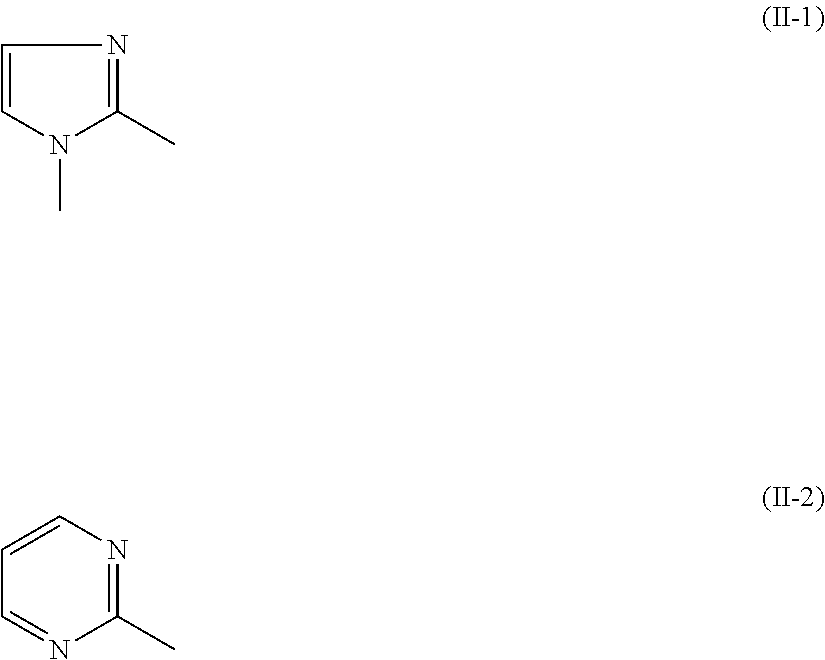Rubber composition, and pneumatic tire using same
a technology of rubber composition and rubber slurry, which is applied in the direction of transportation and packaging, tyre parts, special tyres, etc., can solve the problems of reducing affecting increasing the viscosity of unvulcanized rubber composition, so as to improve the abrasion resistance of tread rubber, improve the abrasion resistance of rubber, and improve the abrasion resistance resistan
- Summary
- Abstract
- Description
- Claims
- Application Information
AI Technical Summary
Benefits of technology
Problems solved by technology
Method used
Image
Examples
production example 1
[0059]50 mL of DMF (N,N-dimethylformamide) and 14.2 g of benzimidazole were added to 6.20 g of bis(2-methanesulfonyloxyethyl) disulfide, and stirred at 65 to 70° C. for 18 hours. This was processed for liquid-liquid separation using 200 mL of ethyl acetate and 300 mL of water. The organic layer was distilled under reduced pressure. This was purified through a silica gel column chromatography (chloroform / methanol) to give 2.10 g of bis[2-(1H-benzimidazol-1-yl)ethyl] disulfane, the compound a represented by the above-mentioned formula (IV).
[0060]1H-NMR (500 MHz, CDCl3, δ ppm): 3.2 (t, 4H), 4.5 (t, 4H), 7.2 (m, 4H), 7.6 (d, 2H), 7.6 (d, 2H), 8.2 (s, 2H)
production example 2
[0061]Bis[2-(1H-imidazol-1-yl)ethyl] disulfane, the compound b represented by the above-mentioned formula (V) was obtained in the same manner as in Production Example 1 except that benzimidazole in Production Example 1 was substituted with the same molar amount of imidazole. This compound is CAS Registry Number: 227937-29-3.
production example 3
[0062]14.4 g of benzimidazole and 100 ml of dewatered tetrahydrofuran were cooled with ice, then 6.72 g of 3,3′-dithiobis(propionyl chloride) (88.9% wt.) was gradually and dropwise added thereto, and thereafter this was restored to room temperature and stirred for 4 hours. The crystal was collected through filtration, then crushed and washed with 200 ml of methanol, the resultant crystal was taken out through filtration and dried under reduced pressure at 40° C. to give 5.5 g of bis[3-(1H-benzimidazol-1-yl)-3-oxopropyl] disulfane, the compound c represented by the above-mentioned formula (VI).
[0063]Property: white solid
[0064]Melting Point: 168° C.
[0065]1H-NMR (500 MHz, DMSO-D6, δ ppm): 3.2 (t, 4H), 3.6 (t, 4H), 7.4 (m, 4H), 7.8 (m, 2H), 8.2 (m, 2H), 9.0 (s, 2H)
PUM
| Property | Measurement | Unit |
|---|---|---|
| nitrogen adsorption specific surface area | aaaaa | aaaaa |
| BET specific surface area | aaaaa | aaaaa |
| mean particle size | aaaaa | aaaaa |
Abstract
Description
Claims
Application Information
 Login to View More
Login to View More - R&D
- Intellectual Property
- Life Sciences
- Materials
- Tech Scout
- Unparalleled Data Quality
- Higher Quality Content
- 60% Fewer Hallucinations
Browse by: Latest US Patents, China's latest patents, Technical Efficacy Thesaurus, Application Domain, Technology Topic, Popular Technical Reports.
© 2025 PatSnap. All rights reserved.Legal|Privacy policy|Modern Slavery Act Transparency Statement|Sitemap|About US| Contact US: help@patsnap.com



